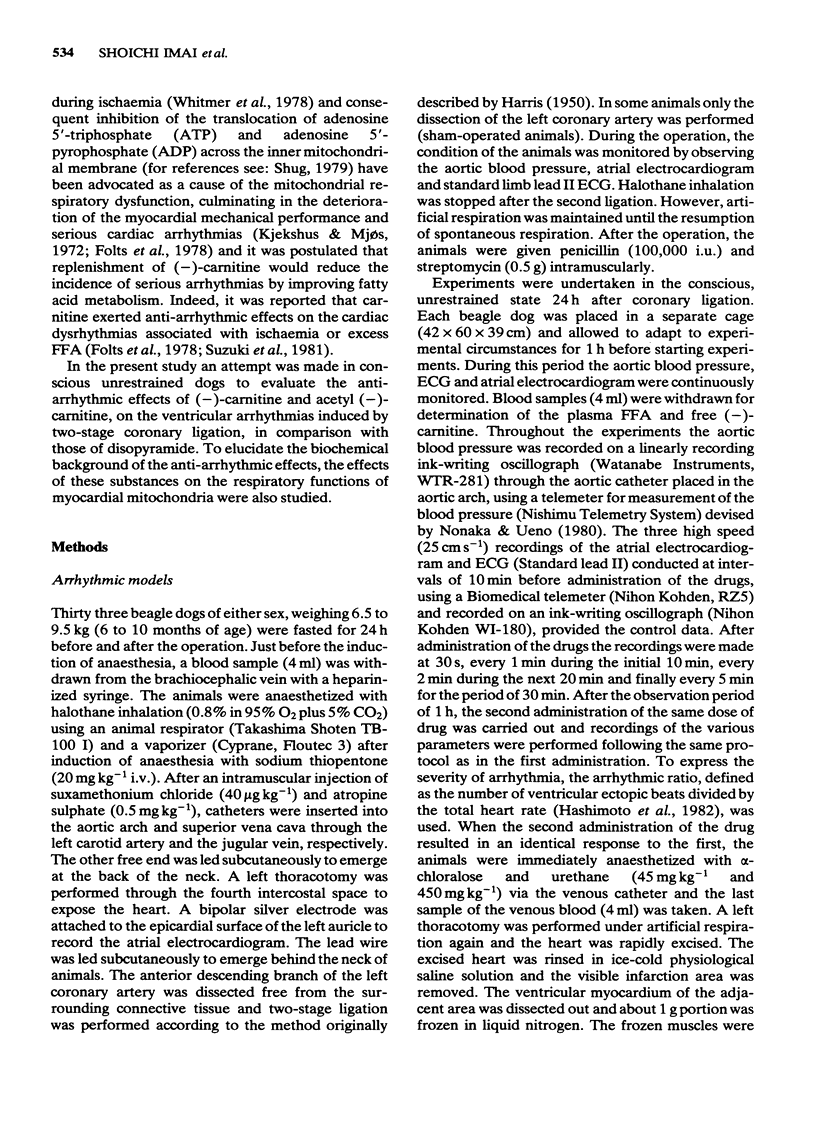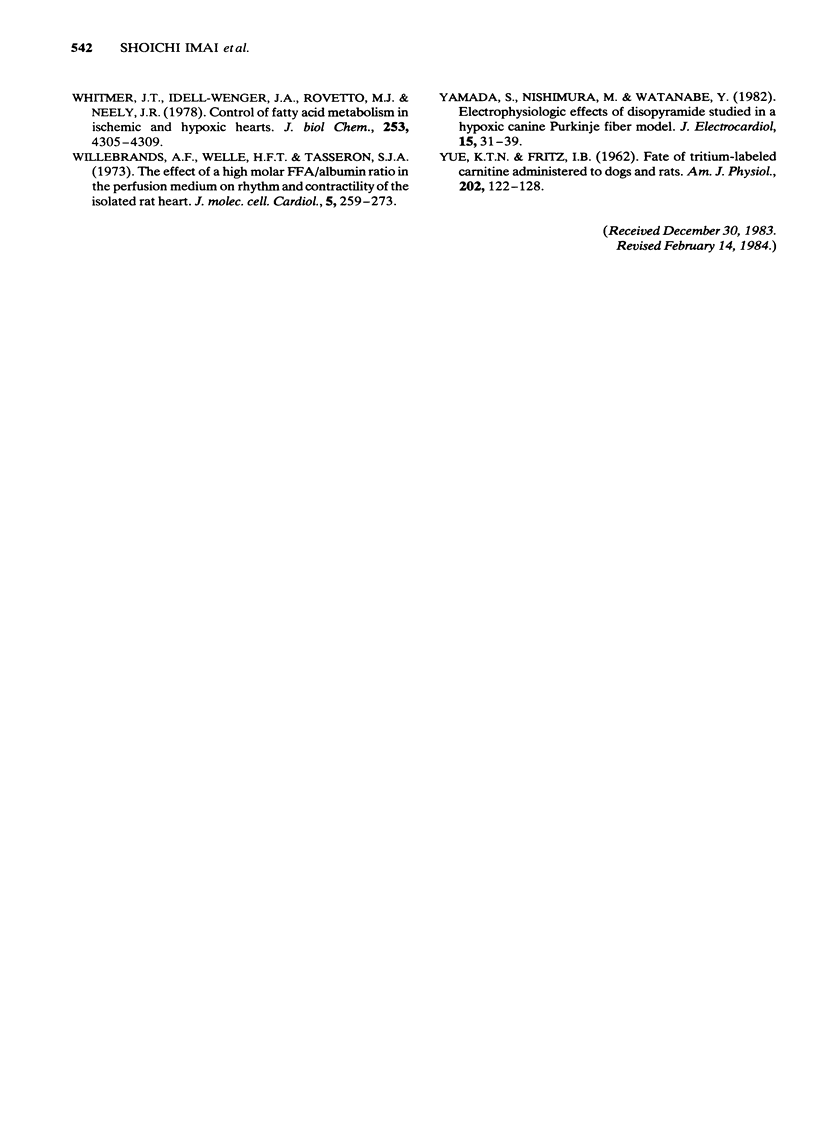Abstract
Using the two-stage coronary ligation method, first described by Harris, (1950), anti-arrhythmic effects (AAE) of (-)-carnitine chloride (LCC) and acetyl (-)-carnitine chloride (ALCC) were studied in conscious unrestrained dogs in comparison with those of disopyramide (D). Two-stage ligation of the coronary artery resulted in a significant decrease in the myocardial free carnitine content. Intravenous administration of LCC (300 mg kg-1) and D (5 mg kg-1) suppressed the ventricular arrhythmia induced by coronary ligation after 24 hours. ALCC (300 mg kg-1) was found to be less potent. An improvement of the mitochondrial function (respiratory control index (RCI) and oxidative phosphorylation rate (OPR) ) was noted with LCC and ALCC and there was a linear correlation between AAE expressed as reduction of arrhythmic ratio and improvement in the OPR, whereas there was no improvement in mitochondrial function after D. Plasma carnitine concentration was increased after administration of LCC, attaining the value of around 8 mM at 10 min after 300 mg kg-1. At 60 min, the plasma carnitine concentration was still about half as high as at 10 min. After ALCC, both acetyl carnitine and free carnitine were found in the plasma. The concentration of the former was decreased after attaining a peak value of around 0.2 mM at 10 min, while the plasma concentration of free carnitine was gradually increased. The anti-arrhythmic effects of LCC and ALCC were ascribed to the improvement of mitochondrial oxidative phosphorylation, while effects other than the improvement of the mitochondrial activity were suggested as mechanisms of anti-arrhythmic effects of D.
Full text
PDF









Selected References
These references are in PubMed. This may not be the complete list of references from this article.
- Blum K., Seifter E., Seifter J. The pharmacology of d- and l-carnitine and d- and l-acetylcarnitine. Comparison with choline and acetylcholine. J Pharmacol Exp Ther. 1971 Aug;178(2):331–338. [PubMed] [Google Scholar]
- Bongrani S., Di Lisa F., Raddino R., Ferrari R., Razzetti R., Visioli O. D,L-Carnitine and D,L-acetylcarnitine actions on myocardial contractility and coronary resistance in isolated perfused rabbit hearts. Farmaco Prat. 1980 May;35(5):239–248. [PubMed] [Google Scholar]
- Brooks H., Goldberg L., Holland R., Klein M., Sanzari N., DeFelice S. Carnitine-induced effects on cardiac and peripheral hemodynamics. J Clin Pharmacol. 1977 Oct;17(10 Pt 1):561–568. doi: 10.1177/009127007701701003. [DOI] [PubMed] [Google Scholar]
- Böhmer T., Eiklid K., Jonsen J. Carnitine uptake into human heart cells in culture. Biochim Biophys Acta. 1977 Mar 17;465(3):627–633. doi: 10.1016/0005-2736(77)90278-4. [DOI] [PubMed] [Google Scholar]
- Cowan J. C., Vaughan Williams E. M. The effects of palmitate on intracellular potentials recorded from Langendorff-erfused guinea-pig hearts in normoxia and hypoxia, and during perfusion at reduced rate of flow. J Mol Cell Cardiol. 1977 Apr;9(4):327–342. doi: 10.1016/s0022-2828(77)80038-2. [DOI] [PubMed] [Google Scholar]
- Cowan J. C., Williams E. M. The effects of various fatty acids on action potential shortening during sequential periods of ischaemia and reperfusion. J Mol Cell Cardiol. 1980 Apr;12(4):347–369. doi: 10.1016/0022-2828(80)90047-4. [DOI] [PubMed] [Google Scholar]
- Danilo P., Jr, Hordof A. J., Rosen M. R. Effects of disopyramide on electrophysiologic properties of canine cardiac purkinje fibers. J Pharmacol Exp Ther. 1977 Jun;201(3):701–710. [PubMed] [Google Scholar]
- Edoute Y., Kotzé J. C., Lochner A. Oxidative phosphorylation rate: an index for evaluation of mitochondrial function in myocardial ischaemia. J Mol Cell Cardiol. 1979 Aug;11(8):831–833. doi: 10.1016/0022-2828(79)90408-5. [DOI] [PubMed] [Google Scholar]
- Folts J. D., Shug A. L., Koke J. R., Bittar N. Protection of the ischemic dog myocardium with carnitine. Am J Cardiol. 1978 Jun;41(7):1209–1214. doi: 10.1016/0002-9149(78)90877-9. [DOI] [PubMed] [Google Scholar]
- HARRIS A. S. Delayed development of ventricular ectopic rhythms following experimental coronary occlusion. Circulation. 1950 Jun;1(6):1318–1328. doi: 10.1161/01.cir.1.6.1318. [DOI] [PubMed] [Google Scholar]
- Hashimoto K., Satoh H., Shibuya T., Imai S. Canine-effective plasma concentrations of antiarrhythmic drugs on the two-stage coronary ligation arrhythmia. J Pharmacol Exp Ther. 1982 Dec;223(3):801–810. [PubMed] [Google Scholar]
- Hashimoto K., Shibuya T., Satoh H., Imai S. Quantitative analysis of the antiarrhythmic effect of drugs on canine ventricular arrhythmias by the determination of minimum effective plasma concentrations. Jpn Circ J. 1983 Jan;47(1):92–97. doi: 10.1253/jcj.47.92. [DOI] [PubMed] [Google Scholar]
- Kjekshus J. K., Mjos O. D. Effect of free fatty acids on myocardial function and metabolism in the ischemic dog heart. J Clin Invest. 1972 Jul;51(7):1767–1776. doi: 10.1172/JCI106978. [DOI] [PMC free article] [PubMed] [Google Scholar]
- Kurien V. A., Yates P. A., Oliver M. F. Free fatty acids, heparin, and arrhythmias during experimental myocardial infarction. Lancet. 1969 Jul 26;2(7613):185–187. doi: 10.1016/s0140-6736(69)91424-x. [DOI] [PubMed] [Google Scholar]
- Kurien V. A., Yates P. A., Oliver M. F. The role of free fatty acids in the production of ventricular arrhythmias after acute coronary artery occlusion. Eur J Clin Invest. 1971 Jan;1(4):225–241. doi: 10.1111/eci.1971.1.4.225. [DOI] [PubMed] [Google Scholar]
- Kus T., Sasyniuk B. I. Effects of disopyramide phosphate on ventricular arrhythmias in experimental myocardial infarction. J Pharmacol Exp Ther. 1976 Mar;196(3):665–675. [PubMed] [Google Scholar]
- Kus T., Sasyniuk B. I. Electrophysiological actions of disopyramide phosphate on canine ventricular muscle and purkinje fibers. Circ Res. 1975 Dec;37(6):844–854. doi: 10.1161/01.res.37.6.844. [DOI] [PubMed] [Google Scholar]
- LOWRY O. H., ROSEBROUGH N. J., FARR A. L., RANDALL R. J. Protein measurement with the Folin phenol reagent. J Biol Chem. 1951 Nov;193(1):265–275. [PubMed] [Google Scholar]
- Liedtke A. J., Nellis S. H. Effects of carnitine in ischemic and fatty acid supplemented swine hearts. J Clin Invest. 1979 Aug;64(2):440–447. doi: 10.1172/JCI109481. [DOI] [PMC free article] [PubMed] [Google Scholar]
- MARQUIS N. R., FRITZ I. B. ENZYMOLOGICAL DETERMINATION OF FREE CARNITINE CONCENTRATIONS IN RAT TISSUES. J Lipid Res. 1964 Apr;5:184–187. [PubMed] [Google Scholar]
- MOKLER C. M., VAN ARMAN C. G. Pharmacology of a new antiarrhythmic agent, gamma-diisopropyl-amino-alpha-phenyl-alpha-(2-pyridyl)-butyramide (SC-7031). J Pharmacol Exp Ther. 1962 Apr;136:114–124. [PubMed] [Google Scholar]
- Matsuda H., Konishi T., Tamamura T., Kadoya M., Kawai C. Electrophysiological effects of disopyramide on hypoxic rabbit ventricular muscle. Jpn Circ J. 1982 Jul;46(7):663–668. doi: 10.1253/jcj.46.663. [DOI] [PubMed] [Google Scholar]
- Molstad P., Bohmer T., Eiklid K. Specificity and characteristics of the carnitine transport in human heart cells (CCL 27) in culture. Biochim Biophys Acta. 1977 Dec 1;471(2):296–304. doi: 10.1016/0005-2736(77)90257-7. [DOI] [PubMed] [Google Scholar]
- Nonaka K., Ueno A. [A system for biological pressure telemetry in conscious animals (author's transl)]. Nihon Yakurigaku Zasshi. 1980 Oct;76(7):549–552. [PubMed] [Google Scholar]
- Oliver M. F., Kurien V. A., Greenwood T. W. Relation between serum-free-fatty acids and arrhythmias and death after acute myocardial infarction. Lancet. 1968 Apr 6;1(7545):710–714. doi: 10.1016/s0140-6736(68)92163-6. [DOI] [PubMed] [Google Scholar]
- Opie L. H. Role of carnitine in fatty acid metabolism of normal and ischemic myocardium. Am Heart J. 1979 Mar;97(3):375–388. doi: 10.1016/0002-8703(79)90440-x. [DOI] [PubMed] [Google Scholar]
- Shug A. L. Control of carnitine-related metabolism during myocardial ischemia. Tex Rep Biol Med. 1979;39:409–428. [PubMed] [Google Scholar]
- Suzuki Y., Kamikawa T., Yamazaki N. Effects of L-carnitine on ventricular arrhythmias in dogs with acute myocardial ischemia and a supplement of excess free fatty acids. Jpn Circ J. 1981 May;45(5):552–559. doi: 10.1253/jcj.45.552. [DOI] [PubMed] [Google Scholar]
- Welling P. G., Thomsen J. H., Shug A. L., Tse F. L. Pharmacokinetics of l-carnitine in man following intravenous infusion of dl-carnitine. Int J Clin Pharmacol Biopharm. 1979 Feb;17(2):56–60. [PubMed] [Google Scholar]
- Whitmer J. T., Idell-Wenger J. A., Rovetto M. J., Neely J. R. Control of fatty acid metabolism in ischemic and hypoxic hearts. J Biol Chem. 1978 Jun 25;253(12):4305–4309. [PubMed] [Google Scholar]
- Willerbrands A. F., ter Welle H. F., Tasseron S. J. The effect of a high molar FFA-albumin ratio in the perfusion medium on rhythm and contractility of the isolated rat heart. J Mol Cell Cardiol. 1973 Jun;5(3):259–273. doi: 10.1016/0022-2828(73)90066-7. [DOI] [PubMed] [Google Scholar]
- YUE K. T., FRITZ I. B. Fate of tritium-labeled carnitine administered to dogs and rats. Am J Physiol. 1962 Jan;202:122–128. doi: 10.1152/ajplegacy.1962.202.1.122. [DOI] [PubMed] [Google Scholar]
- Yamada S., Nishimura M., Watanabe Y. Electrophysiologic effects of disopyramide studied in a hypoxic canine Purkinje fiber model. J Electrocardiol. 1982 Jan;15(1):31–39. doi: 10.1016/s0022-0736(82)80042-3. [DOI] [PubMed] [Google Scholar]


